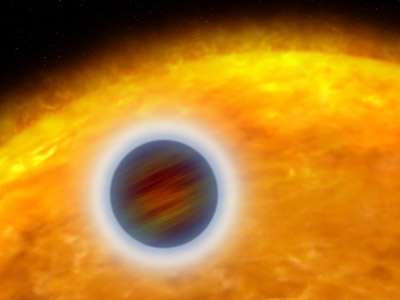The photo itself was taken in 2003, but the study was published this week in Nature. As I remember last week the Hubble's main camera broke down

This is not the picture taken by Hubble but an artist's rendering of the planet losing its atmosphere to space
Hubble's main camera is no longer operational but the images taken so far are still used by researchers around the world. One of them, taken in 2003, appeared in the February 1, 2007 issue of the journal Nature. This is the first observation of the upper layer of the atmosphere of a planet orbiting another sun. Hubble discovered a dense upper layer of hot hydrogen gas, where the planet's very hot atmosphere leaks into space. The system in question is about 150 light years away from Earth.
The planet HD 209458b is unlike any world we know of in the solar system. It orbits its star so closely and the gases in its atmosphere heat up so much that they flow into space and cause the appearance of a comet-like tail. trailing behind the planet. This new research reveals the layer in the planet's upper atmosphere where the gas becomes so hot that it escapes, like steam from a boiling water tank.
"The layer we studied is a transition layer where the temperature rises from a thousand degrees Kelvin to 15 thousand degrees Kelvin, hotter than in the sun. says Gilda Ballester of the University of Arizona in Tucson, lead researcher on the team. "Through this discovery we see for the first time in detail how a planet loses its atmosphere."
The research by Blaster and her colleague David Singh of the University of Arizona and the Institute of Astrophysics in Paris, and Floyd Herbert, also of the University of Arizona, was published on February 1 in a letter to the journal Nature.
The Hubble data show that strong ultraviolet radiation from the local sun heats the gas in the upper atmosphere and inflates the atmosphere like a balloon. The gas is so hot that it moves very fast and escapes the gravity of the planet at a rate of ten thousand tons per second, more than 3 times the rate of water flowing in Niagara Falls. The planet, however, is not going to lose its atmosphere anytime soon. Astronomers estimate that the expected lifespan of the system is about 5 billion years.

4 תגובות
This solar star is close to its sun so there is a slim chance that it is made of solid and has no life on it due to the tremendous heat that exists on its surface.
Father, some more important details are missing.
A. What is its distance from its sun.
B. What is the size of the star, in relation to the Earth (or in relation to Jupiter)
C. What is it made of, gas or solid.
You're right, I missed that figure - 150 light years from Earth.
lack of data:
Distance of the planet that orbits another sun, from the solar system?